If you’re into rare and exotic sports bikes, Ducati’s 916SPS takes some topping. Bruce Wilson tells us what we need to know:
There are some things in life that need zero introduction, such as the Great Wall of China, Big Ben, and chief of them all, Ducati’s 916. It is a motorcycle that has done for motorcycling what the Pyramids have done for Egypt, creating a cult-like following for those that love two wheels, and an education for those that don’t.
From movie scenes to race tracks, it is a motorcycle that has done it all, whilst dutifully delivering exotica on a level so many of its peers could only dream of. In essence, the 916 is special, but as is often the case in life, there are different levels of special out there.
Enjoy everything More Bikes by reading the MoreBikes monthly newspaper. Click here to subscribe, or Read FREE Online.
Ducati’s 916SPS is not a motorcycle you will see every day. In fact, chances are you’ve never seen one in the flesh before, mostly based around the fact that so few were wheeled off the production lines some 30 years ago, and a number of those that did ended up obliterated in a gravel trap. It’s a hen’s tooth of a motorcycle, albeit with much more desirable vibes… and probably more costly, too.
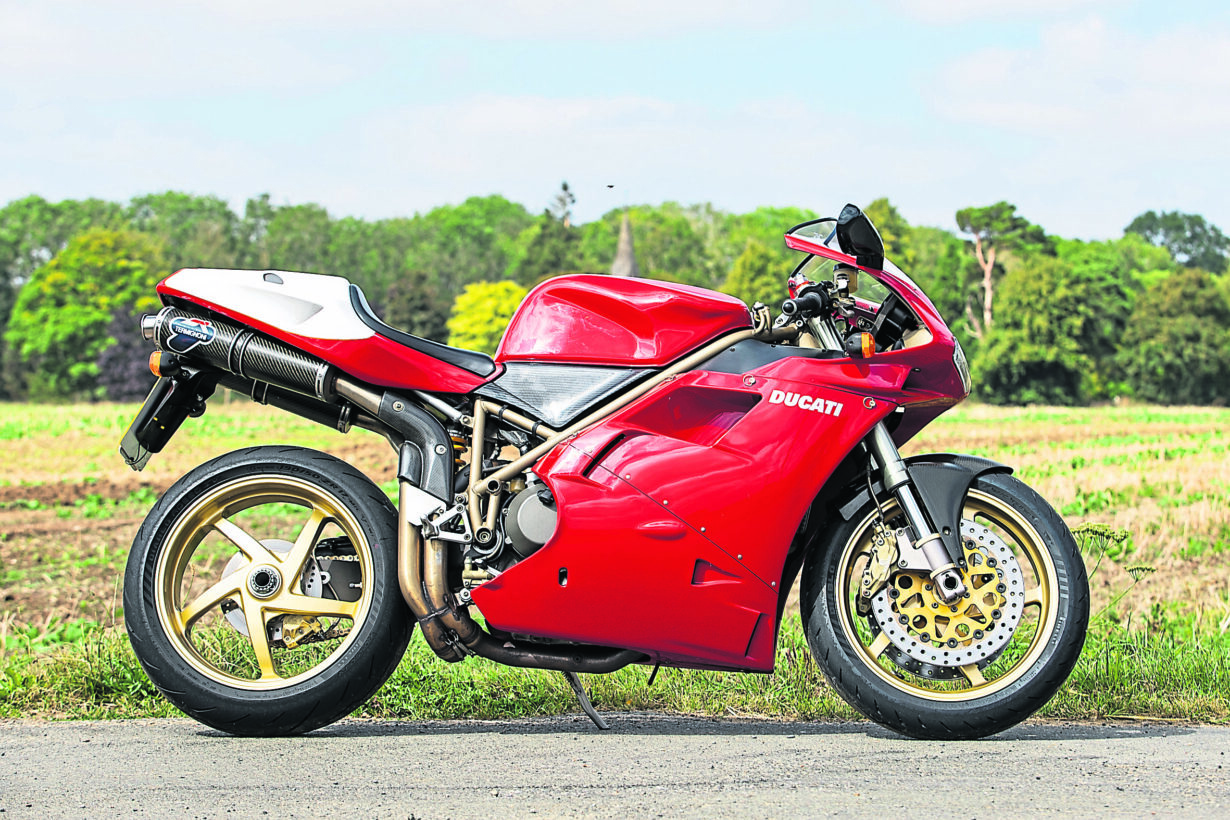
If you were on the hunt for one of these, you’d look to spend upwards of £16,000, which is far more than I’ve got kicking around down the back of the sofa. But for that sum of money you’re not only buying a slice of history, but a feat of engineering, too.
When we talk about homologation specials, we’re basically describing bikes that are designed and built to sport a number plate, but ultimately give a manufacturer an edge on a race track. Making 23bhp more than the standard 916 and weighing a good chunk less, this track-inclined reprobate was born with intent to give Ducati’s riders the edge they needed to lift titles. Which ultimately means that it is a race bike for the roads. But does that mean it’s no good for the streets?
Well, there was only one way to find out and I didn’t exactly hang about, volunteering to find out. I’ve got a lot of love for the whole 916/996/998 era of Ducati v-twins, which arguably owe a chunk of their architecture and success to the 851 and 888 that came before them.
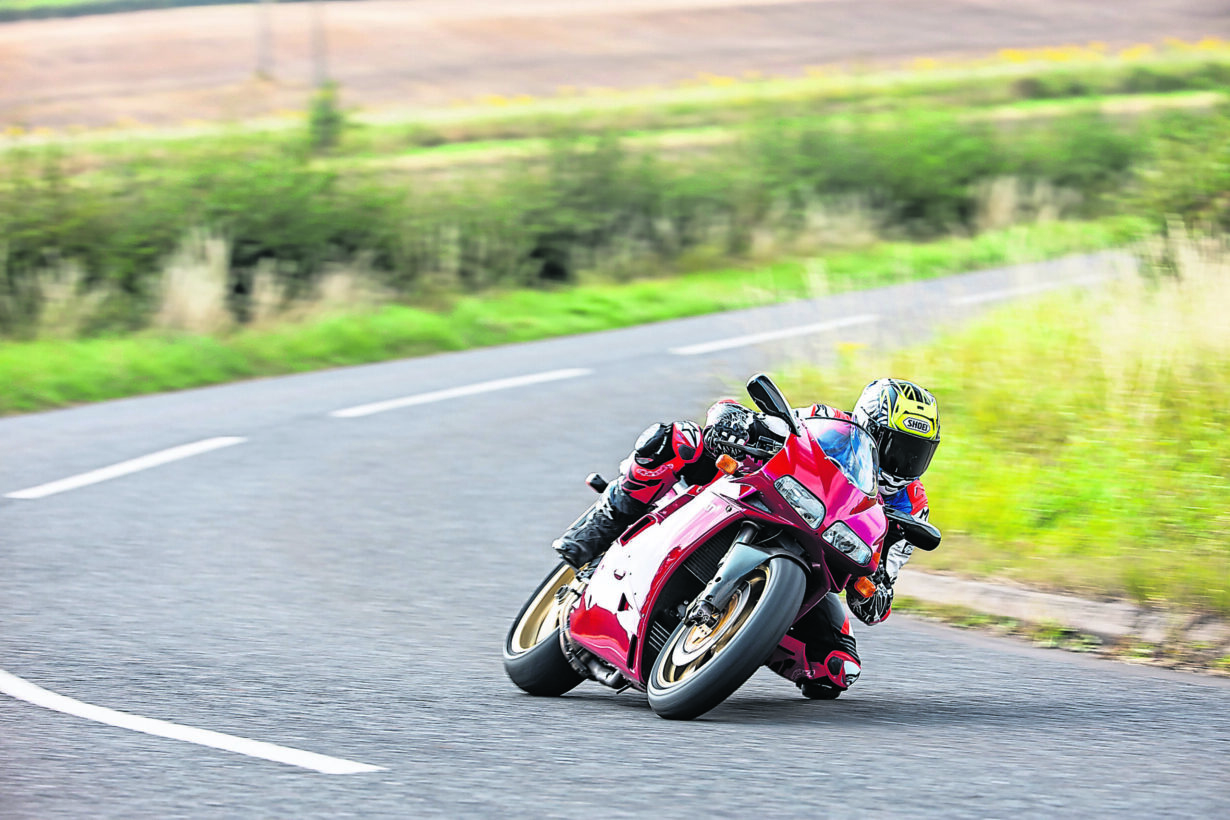
It should be pointed out that Ducati was/is the master of fine tuning and developing platforms, often only changing things drastically if, and when, needed. The point being that as different as this bike might appear on paper, it still felt very much a 916 Strada when it came to trying it out for size. The seat felt tall, the bars nice and low, and the tank was minuscule in width. In fact, the whole bike is super-narrow and it’s only when you park one up next to a conventional in-line four that you realise the advantage this package offers when parked up against the likes of a shed-sized ZX-7R, for instance.
In terms of aerodynamics, Ducati really nailed the brief but they also got it so right in many other areas, least of all in the sound department. Firing the SPS into life, with the fitted Termi cans, slung iconically under the rear seat, is an experience in its own right. The rumble and grumble this thing makes is sensational and only adds to the excitement before you let slip with the clutch and trundle off down the road.
And when I say trundle, I mean it. There are moments in time where I have to hit the pause button and put things into context, which is exactly the case here when talking about the Ducati’s performance. For a machine of its era, this thing was cutting edge and pumping out some serious horsepower… but by comparison to anything of today’s standards, the energy from the V-twin felt a little asthmatic the first time I wound the throttle back in anger. I hate to sound negative about such a beautiful machine, but the performance just simply didn’t live up to the looks of the thing.
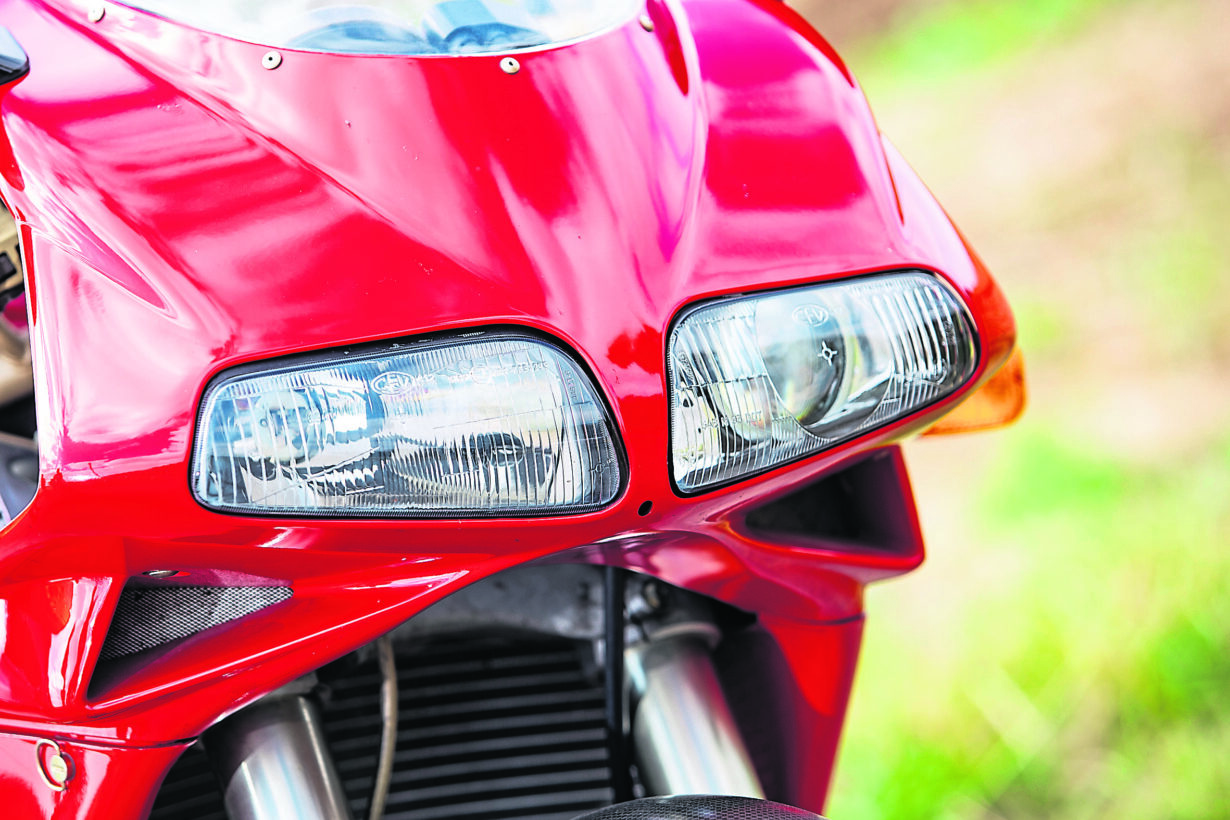
Of course, having dried my tears, I soon learned to love what was on offer, which can be best described as playful and predictable power, befitting to back lane blasts without concern for your collarbones. The spread of power in the motor is both linear and easy to master, with perhaps a little more peak up top than on a Strada, but not to the extent that you’d really tell the difference between the two specs unless you had them in a drag race.
One thing that was hard to ignore was the impact of the shorter gear ratios, achieving peak revs much quicker than you can on the longer geared base model. The fuelling was also impressive for a bike of its age, smoothly translating handfuls of gas to the rear wheel without pause or delay.
Where things got a little more exciting was when downshifting, which could prompt some serious back torque and rear wheel hopping if I were to get a little over-zealous with my riding. That said, it helped form a character to this bike and I quite liked the fact it would throw some abuse back at me if I was being abusive to it. In fact, the thing that sets this machine apart from pretty much any motorcycle of today is its character, owing to its quirks and idiosyncrasies. And, of course, that booming soundtrack. It’s very much alive, and the more I rode it the more I came to appreciate its offerings.
To try this bike out for size properly I did a lot of miles down my favourite routes and came to appreciate that the SPS was a stable motorcycle that required a bit of energy to get it in and through a bend. As light as it is, you can literally feel that the handling is generationally lesser than even the 999, let alone anything that came after that. It makes you think a little harder about your lines, your entry speed, and how early you can get on the throttle.
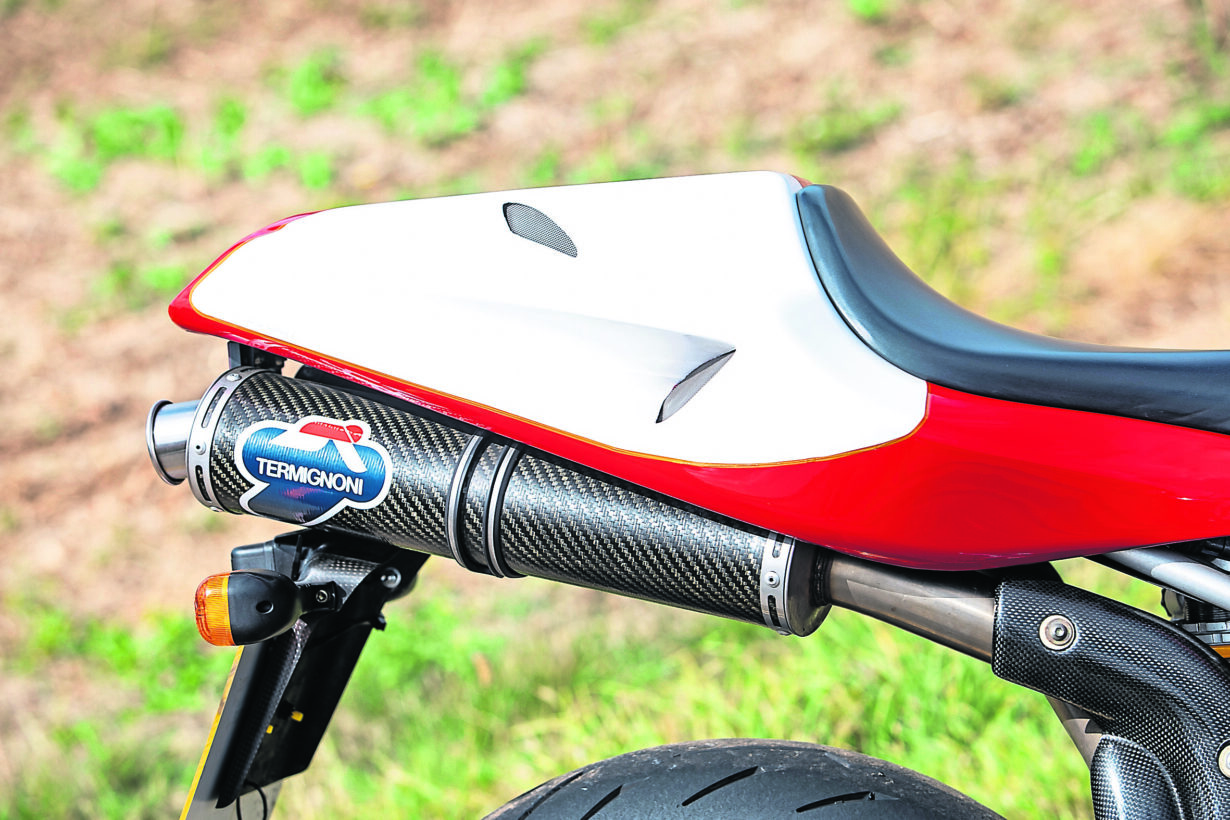
If ever I were too greedy, the bike had a tendency to run a little wide, prompting me to question whether a bit more rear ride height wouldn’t have gone a miss. Likewise, a bit more compression up front could’ve stopped the forks from diving so much when squeezing on the plentifully powerful Brembo 4-pots.
Truth is, I didn’t want this bike to be perfect. I didn’t want it to feel like any other contemporary sports bike – I wanted it to be exactly how it was. Every ride on this thing won me over a little bit more, and providing I stayed away from newer machines, its eccentricities seemed to feel much more normal and less of a shock to the system. And even when there were times when I felt like it needed fighting a little more than I wanted, I’d soon forgive the Ducati by simply looking at it.
Parked up, it looked spectacular and when riding, taking in details such as the numbered top-yoke or the top-mounted steering damper, I couldn’t help but warm to the thing. Hell, even the double analogue dials won me over.
While I’ll probably never know why Ducati decided to go fluoro green with the rev counter digits, I also know that it somehow makes sense and helps to make this bike what it is, along with the abundance of gold found on the frame, the wheels and even the bolts that hold this thing together. It truly is a thing of beauty and something to be savoured more so than savaged. And as for those headlights… I’m yet to find a more iconic set that’s ever existed. Bellissimo!
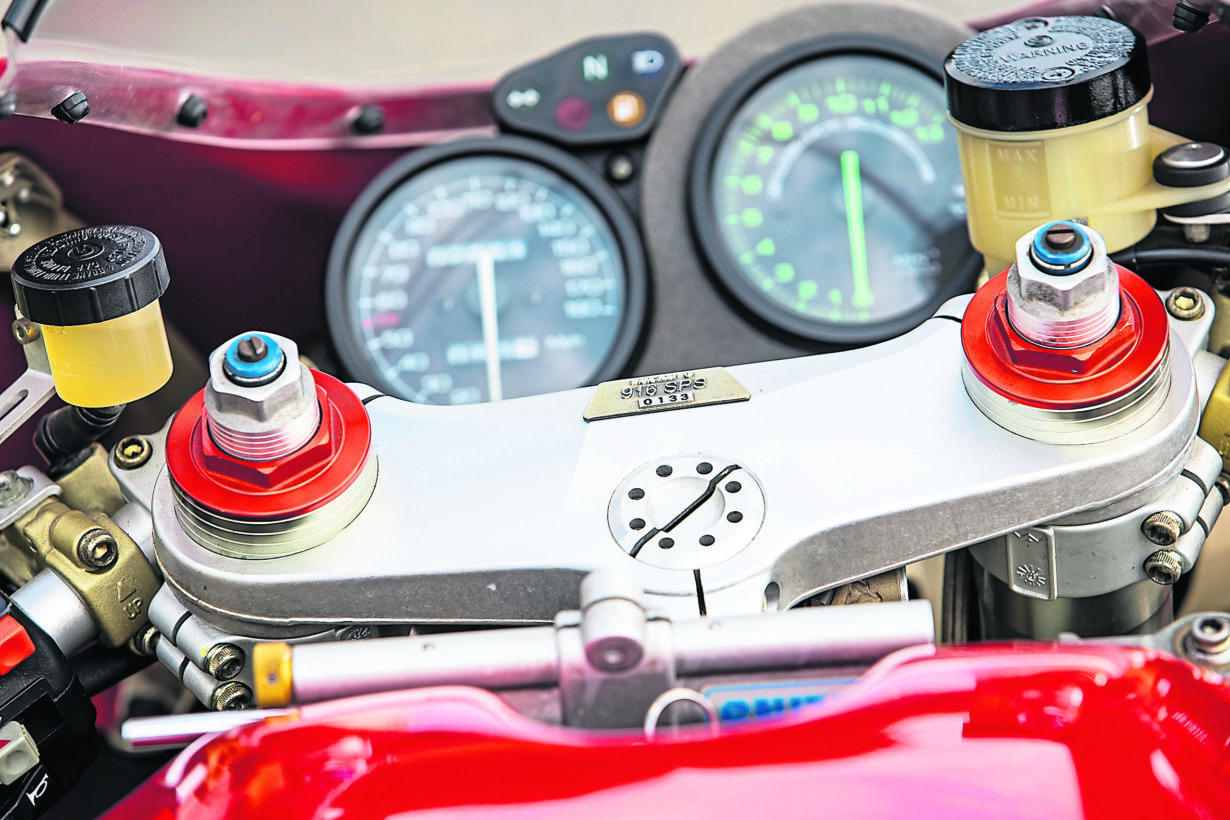
Ducati 916SPS: What makes it special?
Technically, the SPS is actually the second of Ducati’s homologation-special road bikes, however few either remember or have seen its predecessor. The 916SP arrived in 1995 (a year after the 916 Strada road bike) and was made in 1995 and 1996. A genuine 916cc, the 916SP has the usual SP goodies (more on these later) but lacks the SPS’s numbered plaque on its top yoke, which is the reason few realise it exists – unless you are a real geek, it looks much like a tarted-up 916 Strada! Now on to the SPS, of which less than 1400 were made.
The SPS features a 996cc engine (the road bikes were 916cc) thanks to a 4mm bigger bore (like the race bikes) and within the engine the pistons are lightweight, the H-section con rods built from titanium by Pankl, the cams more aggressively profiled, valves bigger and the crank lightened and specially balanced. The gearbox also has lower ratios than the 916 Strada runs, which are actually taken from the 748.
Where the 916 made a claimed 100bhp, the SPS makes 123bhp and it also runs twin injectors per cylinder where the Strada only has single items and arrived with both road-legal cans and race-only Termignoni carbon end pipes. Chassis-wise, the SPS features fully-adjustable Showa forks with an Öhlins shock and Brembo brakes with cast iron fully floating discs (which rattle). While the SPS’s fairing is made from plastic, the V-piece is carbon and so is the undertray and front mudguard, and some bikes also had carbon chain guards and occasionally a carbon airbox, depending if Ducati had any kicking around when it was built!
The SPS was updated in its second model year but the differences are minimal with the con rods’ design upgraded, rocker arms tweaked and logos changed on the fairing and tank for some markets.
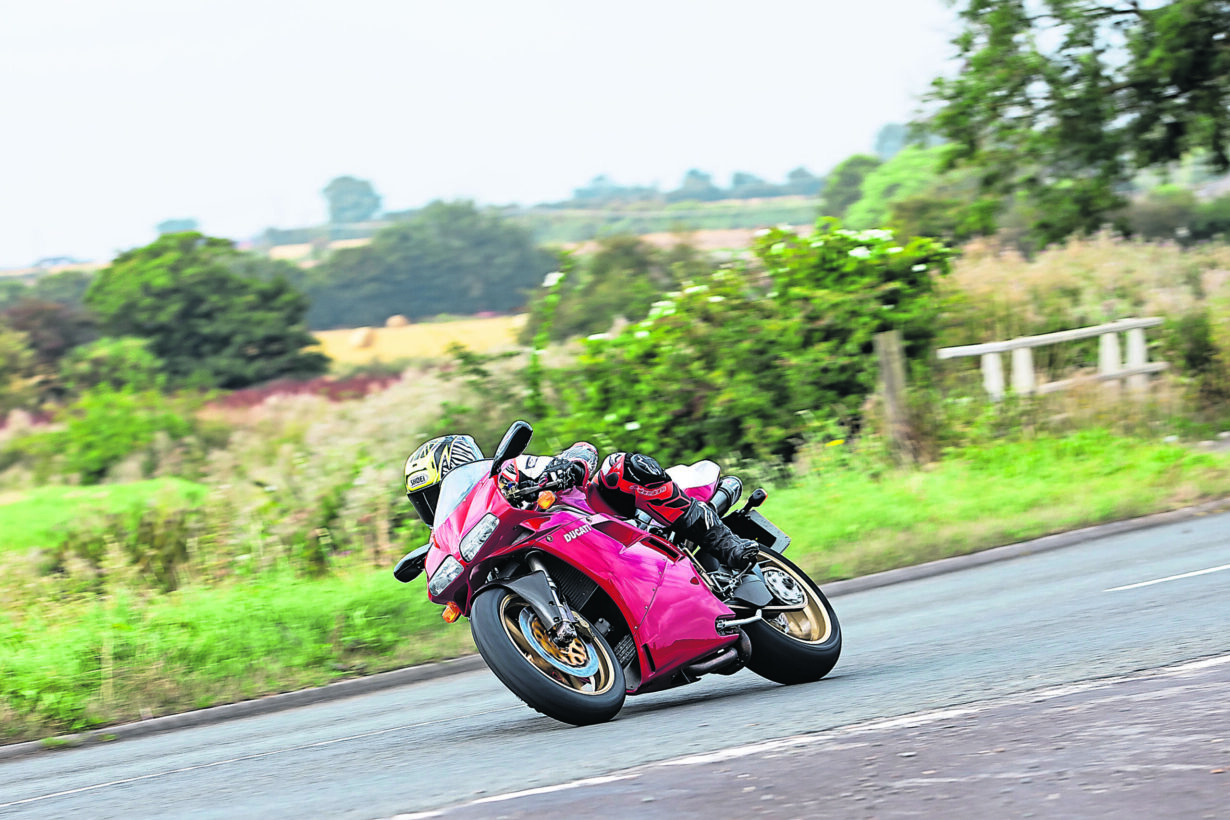
Buying one? Here’s what you need to know…
The first thing to check when buying any limited-edition Ducati model is the fact it is actually what it claims to be. It is very easy to make a Strada (which lacks a pillion seat, that arrived with the Biposto) look like an SP. The ideal thing to do is get its frame number and run it through Ducati, who keep records of every bike. They will tell you if it is an SP or a Strada. The frame number is located on the headstock and is another thing to check, not only that it matches the logbook, but also that it is easy to read and is comprised of a series of raised dots making up the numbers.
When a 916 is restored and its frame repainted, these dots trap paint, making the frame number hard to read. If this is the case, the bike has been resprayed and you need to ask why. Also check the engine number with Ducati, in case the motor has been swapped (the SPS engine is quite trick, see below) for a stock engine. An SPS has an aluminium subframe with no pillion peg mountings where the Strada has a steel item, so check it with a magnet, and also look for the numbered plaque on the top yoke.
When new, the SPS came with a few goodies such as a paddock stand painted in the same colour as the bike’s frame, which is hard to track down and costly used, and a dust cover. Ideally get these parts as they add to the bike’s value to collectors.
When it comes to the mechanicals, the SPS is the same as any 916-based Ducati model. You need to check its service history for when its belts were changed (every two years) and valve clearances were last checked (every 6000 miles); ensure the alternator’s nut has been tightened recently; the swingarm’s eccentric hub isn’t seized; and that the engine isn’t leaking either coolant or clutch fluid from the slave cylinder.
Generally, an SPS model will have fairly low mileage so it’s more a case of getting one with a good service history from a known Ducati expert than become hung up too much on mechanical worries.
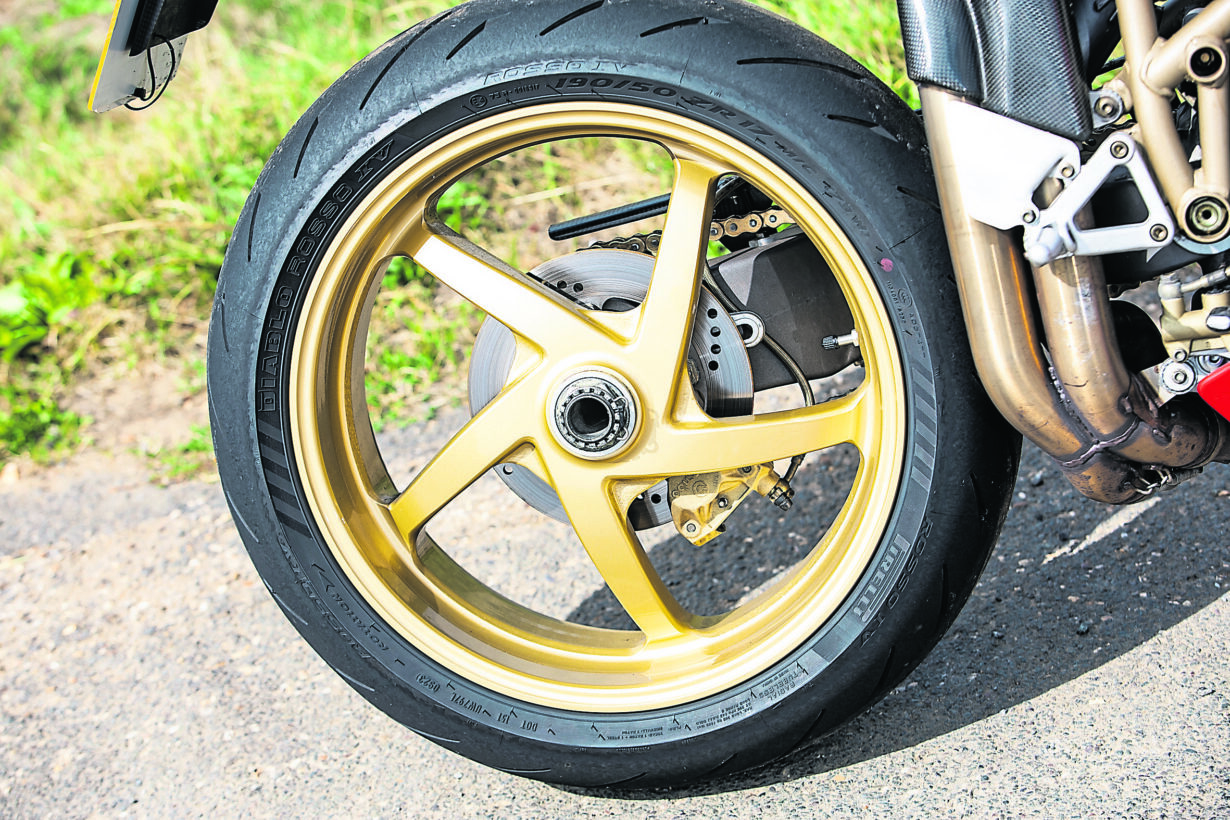
Specs: Ducati 916SPS (1996-1998)
Price: £16,000-£22,000
Engine:
Type: 996cc, liquid-cooled, 8v, desmo V-twin
Bore x Stroke: 98mm x 66mm
Compression: 11:1
Fuelling: Electronic fuel-injection
Tested Power: 123bhp @ 10,500rpm
Tested Torque: 99Nm @ 7000rpm
Chassis
Frame: Steel trellis
F Suspension: Showa 43mm inverted forks, fully-adjustable
R suspension: Öhlins monoshock, fully-adjustable
Front brakes: 2 x four-piston Brembo calipers, 320mm discs
Rear brake: Two-piston caliper, 220mm disc
Dimensions:
Wheelbase: 1410mm
Seat Height: 790mm
Dry Weight: 190kg
Fuel Capacity: 17 litres


